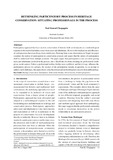Please use this identifier to cite or link to this item:
https://elibrary.khec.edu.np:8080/handle/123456789/106Full metadata record
| DC Field | Value | Language |
|---|---|---|
| dc.contributor.author | Chapagain, Neel Kamal | - |
| dc.date.accessioned | 2022-04-10T11:29:05Z | - |
| dc.date.available | 2022-04-10T11:29:05Z | - |
| dc.date.issued | 2012-02 | - |
| dc.identifier.uri | https://doi.org/10.3126/jsce.v1i0.22493 | - |
| dc.description.abstract | Participatory approach has been used in conservation of historic built environments as a methodological response to the need of including voices from users and inhabitants. However the implication and efficiency of such processes have not always been satisfactory. Drawing from some observations in Nepal, the paper examines the notion of participation in conservation projects and argues that the notion of participation shall be understood from multiple positions. The paper argues that participation is not just about getting users and inhabitants involved in the process, but it should also be about orienting the professionals in the given social context. Unless a professional realizes his/her own worldview and how it may influence the participatory process in a project, the essence of the participation remains in question. As an attempt to address such challenges, this paper draws some theoretical and methodological concepts from anthropology. | en_US |
| dc.language.iso | en | en_US |
| dc.subject | Heritage conservation, Participation, Professional attitudes, Self-reflexivity, Situated perspective | en_US |
| dc.title | RETHINKING PARTICIPATORY PROCESS IN HERITAGE CONSERVATION: SITUATING PROFESSIONALS IN THE PROCESS | en_US |
| dc.type | Article | en_US |
| Appears in Collections: | Journal of Science and Engineering Vol.1 | |
Files in This Item:
| File | Description | Size | Format | |
|---|---|---|---|---|
| Neel Kamal Chapagain.pdf | JScE Vol.I | 273.09 kB | Adobe PDF |  View/Open |
Items in DSpace are protected by copyright, with all rights reserved, unless otherwise indicated.
